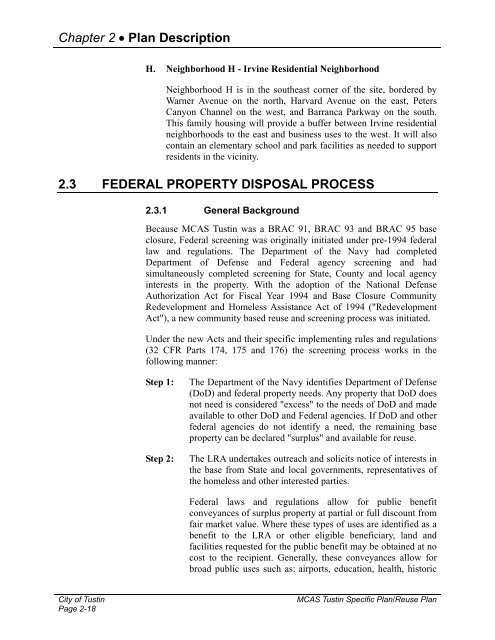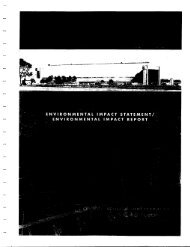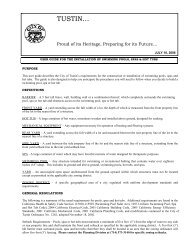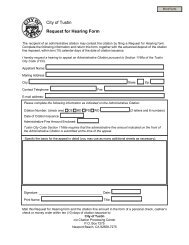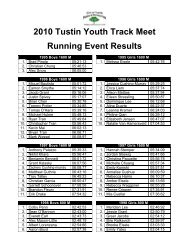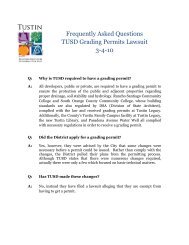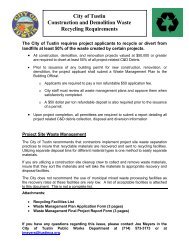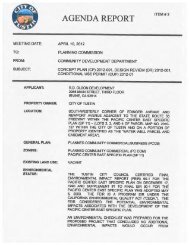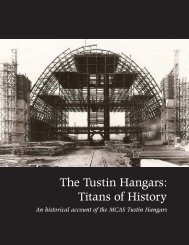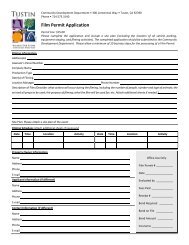- Page 1 and 2: THE FUTURE TUSTIN CPLAN
- Page 3 and 4: Table of Contents Page Chapter 1. I
- Page 5 and 6: Table of Contents Page 3.5 NEIGHBOR
- Page 7 and 8: Table of Contents Page 4.4.4 Circul
- Page 9 and 10: Table of Contents Page Figure 2-32a
- Page 11 and 12: Chapter 1 1. Introduction 1.1 PURPO
- Page 13 and 14: Chapter 1 • Introduction Irvine w
- Page 15 and 16: Chapter 1 • Introduction Local Se
- Page 17 and 18: Chapler 1 • Introduction Existing
- Page 19 and 20: Chapter 1 • Introduction Continui
- Page 21 and 22: Chapter 1 • Introduction 1.3.5 Re
- Page 23 and 24: Chapter 1 • Introduction • Acqu
- Page 25 and 26: Chapter 1 • Introduction 4. Oppor
- Page 27 and 28: Chapter 1 • Introduction disrupte
- Page 29 and 30: Chapter 1 • Introduction • Dist
- Page 31 and 32: Chapter 1 • Introduction A key fu
- Page 33 and 34: Chapter 2 2. Plan Description 2.1 P
- Page 35 and 36: CITY OF TUSTIN SCRRA/OCT A RM.WAY C
- Page 37 and 38: Chapter 2 • Plan Description The
- Page 39 and 40: Chapter 2 • Plan Description supp
- Page 41 and 42: Chapter 2 • Plan Description orie
- Page 43 and 44: Chapter 2 • Plan Description 1) p
- Page 45 and 46: Chapter 2 • Plan Description Neig
- Page 47 and 48: Chapter 2 • Plan Description TABL
- Page 49: Chapter 2 • Plan Description larg
- Page 53 and 54: Chapter 2 • Plan Description •
- Page 55 and 56: Chapter 2 • Plan Description •
- Page 57 and 58: Chapter 2 • Plan Description •
- Page 59 and 60: Chapter 2 • Plan Description •
- Page 61 and 62: Chapter 2 • Plan Description Irvi
- Page 63 and 64: Chapter 2 • Plan Description prop
- Page 65 and 66: Chapter 2 • Plan Description 10.
- Page 67 and 68: Chapter 2 • Plan Description to o
- Page 69 and 70: Chapter 2 • Plan Description Forc
- Page 71 and 72: Chapter 2 • Plan Description comm
- Page 73 and 74: Chapter 2 • Plan Description The
- Page 75 and 76: Chapter 2 • Plan Description Orga
- Page 77 and 78: Chapter 2 • Plan Description Plan
- Page 79 and 80: Chapter 2 • Plan Description TABL
- Page 81 and 82: ~ Chapter 2 • Plan Description Pr
- Page 83 and 84: Chapter 2 • Plan Description 2.4
- Page 85 and 86: Chapter 2 • Plan Description EDC
- Page 87 and 88: Chapter 2 • Plan Description F. H
- Page 89 and 90: 2.5 CIRCULATION PLAN Chapter 2 •
- Page 91 and 92: Chapter 2 • Plan Description sign
- Page 93 and 94: Chapter 2 • Plan Description 7. P
- Page 95 and 96: Chapter 2 • Plan Description Circ
- Page 97 and 98: Chapter 2 • Plan Description B. S
- Page 99 and 100: ) Harvard Avenue Chapter 2 • Plan
- Page 101 and 102:
7. Arterial Right-of-Way Dedication
- Page 103 and 104:
Chapter 2 • Plan Description •
- Page 105 and 106:
Chapter 2 • Plan Description feet
- Page 107 and 108:
Chapter 2 • Plan Description The
- Page 109 and 110:
Chapter 2 • Plan Description Regi
- Page 111 and 112:
Chapter 2 • Plan Description 2.6.
- Page 113 and 114:
Chapter 2 • Plan Description port
- Page 115 and 116:
Chapter 2 • Plan Description the
- Page 117 and 118:
Chapter 2 • Plan Description Pipe
- Page 119 and 120:
Chapter 2 • Plan Description Dome
- Page 121 and 122:
Chapter 2 • Plan Description 2.10
- Page 123 and 124:
Chapter 2 • Plan Description Recl
- Page 125 and 126:
Chapter 2 • Plan Description 2.11
- Page 127 and 128:
Chapter 2 • Plan Description Sani
- Page 129 and 130:
Chapter 2 • Plan Description Parc
- Page 131 and 132:
Chapter 2 • Plan Description Stor
- Page 133 and 134:
Chapter 2 • Plan Description The
- Page 135 and 136:
Chapter 2 • Plan Description Elec
- Page 137 and 138:
Chapter 2 • Plan Description 2.14
- Page 139 and 140:
Chapter 2 • Plan Description Natu
- Page 141 and 142:
Chapter 2 • Plan Description 2.15
- Page 143 and 144:
Chapter 2 • Plan Description Tele
- Page 145 and 146:
Chapter 2 • Plan Description Cabl
- Page 147 and 148:
Chapter 2 • Plan Description 2.17
- Page 149 and 150:
Chapter 2 • Plan Description Comm
- Page 151 and 152:
Chapter 2 • Plan Description C. V
- Page 153 and 154:
Chapter 2. Plan Description Primary
- Page 155 and 156:
Chapter 2 • Plan Description •
- Page 157 and 158:
Chapter 2 • Plan Description Key
- Page 159 and 160:
Chapter 2. Plan Description Tustin
- Page 161 and 162:
Chapter 2. Plan Description Warner
- Page 163 and 164:
Chapter 2 • Plan Description Arms
- Page 165 and 166:
Chapter 2. Plan Description Moffett
- Page 167 and 168:
Chapter 2 • Plan Description Marb
- Page 169 and 170:
Chapter 2 • Plan Description This
- Page 171 and 172:
Chapter 2. Plan Description Redhill
- Page 173 and 174:
Chapter 2. Plan Description Edinger
- Page 175 and 176:
Chapter 2. Plan Description Edinger
- Page 177 and 178:
Chapter 2. Plan Description Barranc
- Page 179 and 180:
Chapter 2. Plan Description Harvard
- Page 181 and 182:
Chapter 2 • Plan Description with
- Page 183 and 184:
Chapter 2 • Plan Description •
- Page 185 and 186:
Chapter 2 • Plan Description •
- Page 187 and 188:
Chapter 2 • Plan Description •
- Page 189 and 190:
Chapter 2 • Plan Description •
- Page 191 and 192:
Chapter 2 • Plan Description •
- Page 193 and 194:
Chapter 2 • Plan Description It i
- Page 195 and 196:
Chapter 2 • Plan Description •
- Page 197 and 198:
Chapter 2 • Plan Description •
- Page 199 and 200:
Chapter 2 • Plan Description b) D
- Page 201 and 202:
Chapter 2 • Plan Description deve
- Page 203 and 204:
Chapter 2 • Plan Description •
- Page 205 and 206:
Chapter 2 • Plan Description This
- Page 207 and 208:
Chapter 3 • Land Use and Developm
- Page 209 and 210:
Chapter 3 • Land Use and Developm
- Page 211 and 212:
Chapter 3 Land Use and Development
- Page 213 and 214:
Chapter 3 • Land Use and Developm
- Page 215 and 216:
Chapter 3 Land Use and Development
- Page 217 and 218:
Chapter 3 Land Use and Development
- Page 219 and 220:
Chapter 3 Land Use and Development
- Page 221 and 222:
Chapter 3 Land Use and Development
- Page 223 and 224:
Chapter 3 Land Use and Development
- Page 225 and 226:
Chapter 3 Land Use and Development
- Page 227 and 228:
Chapter 3 Land Use and Development
- Page 229 and 230:
Chapter 3 Land Use and Development
- Page 231 and 232:
Chapter 3 Land Use and Development
- Page 233 and 234:
Chapter 3 Land Use and Development
- Page 235 and 236:
Chapter 3 Land Use and Development
- Page 237 and 238:
Chapter 3 Land Use and Development
- Page 239 and 240:
Chapter 3 Land Use and Development
- Page 241 and 242:
Chapter 3 Land Use and Development
- Page 243 and 244:
Chapter 3 Land Use and Development
- Page 245 and 246:
Chapter 3 Land Use and Development
- Page 247 and 248:
Chapter 3 Land Use and Development
- Page 249 and 250:
Chapter 3 Land Use and Development
- Page 251 and 252:
Chapter 3 Land Use and Development
- Page 253 and 254:
Chapter 3 Land Use and Development
- Page 255 and 256:
Chapter 3 Land Use and Development
- Page 257 and 258:
Chapter 3 Land Use and Development
- Page 259 and 260:
Chapter 3 Land Use and Development
- Page 261 and 262:
Chapter 3 Land Use and Development
- Page 263 and 264:
Chapter 3 . Land Use and Developmen
- Page 265 and 266:
Chapter 3 Land Use and Development
- Page 267 and 268:
Chapter 3 Land Use and Development
- Page 269:
Chapter 3 Land Use and Development
- Page 272 and 273:
Chapter 3 Land Use and Development
- Page 274 and 275:
Chapter 3 Land Use and Development
- Page 276 and 277:
Chapter 3 Land Use and Development
- Page 278 and 279:
Chapter 3 Land Use and Development
- Page 280 and 281:
Chapter 3 Land Use and Development
- Page 283 and 284:
Chapter 3 Land Use and Development
- Page 285 and 286:
Chapter 3 Land Use and Development
- Page 287 and 288:
Chapter 3 Land Use and Development
- Page 290 and 291:
Chapter 3 Land Use and Development
- Page 292 and 293:
Chapter 3 Land Use and Development
- Page 294 and 295:
Chapter 3 Land Use and Development
- Page 296 and 297:
Chapter 3 Land Use and Development
- Page 298 and 299:
Chapter 3 Land Use and Development
- Page 300 and 301:
Chapter 3 Land Use and Development
- Page 302 and 303:
Chapter 3 Land Use and Development
- Page 305 and 306:
Chapter 3 Land Use and Development
- Page 307 and 308:
Chapter 3 Land Use and Development
- Page 309 and 310:
Chapter 3 Land Use and Development
- Page 311 and 312:
Chapter 3 Land Use and Development
- Page 313 and 314:
Chapter 3 Land Use and Development
- Page 315 and 316:
Chapter 3 Land Use and Development
- Page 317 and 318:
Chapter 3 Land Use and Development
- Page 319 and 320:
Chapter 3 Land Use and Development
- Page 321 and 322:
Chapter 3 Land Use and Development
- Page 323 and 324:
Chapter 3 Land Use and Development
- Page 325 and 326:
Chapter 3 Land Use and Development
- Page 327 and 328:
Chapter 3 Land Use and Development
- Page 329 and 330:
Chapter 3 Land Use and Development
- Page 331 and 332:
Chapter 3 Land Use and Development
- Page 333 and 334:
Chapter 3 Land Use and Development
- Page 335 and 336:
Chapter 3 Land Use and Development
- Page 337:
Chapter 3 Land Use and Development
- Page 340 and 341:
Chapter 3 Land Use and Development
- Page 342:
Chapter 3 Land Use and Development
- Page 345 and 346:
Chapter 3 Land Use and Development
- Page 347 and 348:
Chapter 3 Land Use and Development
- Page 349 and 350:
Chapter 3 Land Use and Development
- Page 351 and 352:
Chapter 3 Land Use and Development
- Page 353 and 354:
Chapter 3 Land Use and Development
- Page 355 and 356:
Chapter 3 Land Use and Development
- Page 357 and 358:
Chapter 3 Land Use and Development
- Page 359 and 360:
Chapter 3 Land Use and Development
- Page 361 and 362:
Chapter 3 Land Use and Development
- Page 363 and 364:
Chapter 3 Land Use and Development
- Page 365 and 366:
Chapter 3 Land Use and Development
- Page 367 and 368:
Chapter 3 Land Use and Development
- Page 369 and 370:
Chapter 3 Land Use and Development
- Page 371 and 372:
Chapter 4 • Specific Plan Adminis
- Page 373 and 374:
Chapter 4 • Specific Plan Adminis
- Page 375 and 376:
Chapter 4 • Specific Plan Adminis
- Page 377 and 378:
Chapter 4 • Specific Plan Adminis
- Page 379 and 380:
Chapter 4 Specific Plan Administrat
- Page 381 and 382:
Chapter 4 Specific Plan Administrat
- Page 383 and 384:
Chapter 4 • Specific Plan Adminis
- Page 385 and 386:
Chapter 4 • Specific Plan Adminis
- Page 387 and 388:
Chapter 4 • Specific Plan Adminis
- Page 389 and 390:
Chapter 4 • Specific Plan Adminis
- Page 391 and 392:
Chapter 5 • Plan Implementation S
- Page 393 and 394:
Chapter 5 • Plan Implementation S
- Page 395 and 396:
Chapter 5 • Plan Implementation S
- Page 397 and 398:
Chapter 5 • Plan Implementation S
- Page 399 and 400:
Chapter 5 • Plan Implementation S
- Page 401 and 402:
Chapter 5 • Plan Implementation S
- Page 403 and 404:
Chapter 5 • Plan Implementation S
- Page 405 and 406:
Chapter 5 • Plan Implementation S
- Page 407 and 408:
Chapter 5 • Plan Implementation S
- Page 409 and 410:
Appendices • Promote expansion of
- Page 411 and 412:
Appendices • Reduce air pollution
- Page 413 and 414:
Appendices conditioners. The follow
- Page 415 and 416:
Appendices In an effort to rehabili
- Page 417 and 418:
Appendices not indicate whether sim
- Page 419 and 420:
Appendices • The program can be a
- Page 421 and 422:
Appendices • The proposal had no
- Page 423 and 424:
Appendices • The program is a dup
- Page 425 and 426:
Appendices The Task Force denied th
- Page 427 and 428:
Appendices Village if the proposed
- Page 429 and 430:
Appendices which would create an im
- Page 431 and 432:
Appendices • A large portion of t
- Page 433 and 434:
Appendices park as well as necessar
- Page 435 and 436:
Appendices of the channel for a maj
- Page 437 and 438:
Appendices PRELIMINARY BUILDING CON
- Page 439 and 440:
Appendices Bldg. No. PRELIMINARY BU
- Page 441 and 442:
Appendices PRELIMINARY BUILDING CON
- Page 443 and 444:
Appendices PRELIMINARY BUILDING CON
- Page 445 and 446:
Appendices D. DEFINITIONS Words, ph
- Page 447 and 448:
Appendices Development Unit. Consis
- Page 449:
Appendices Tenure. The ownership st


